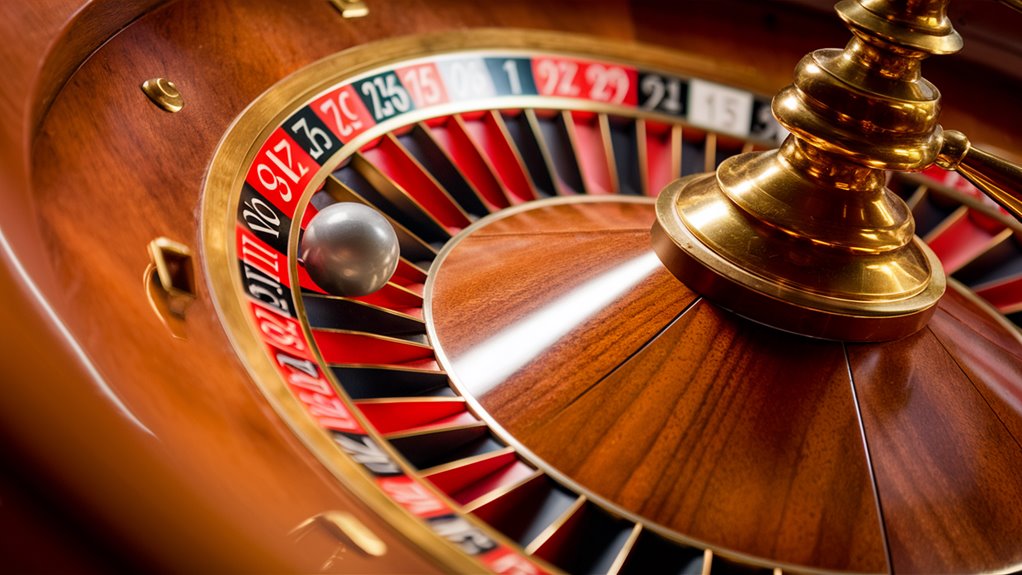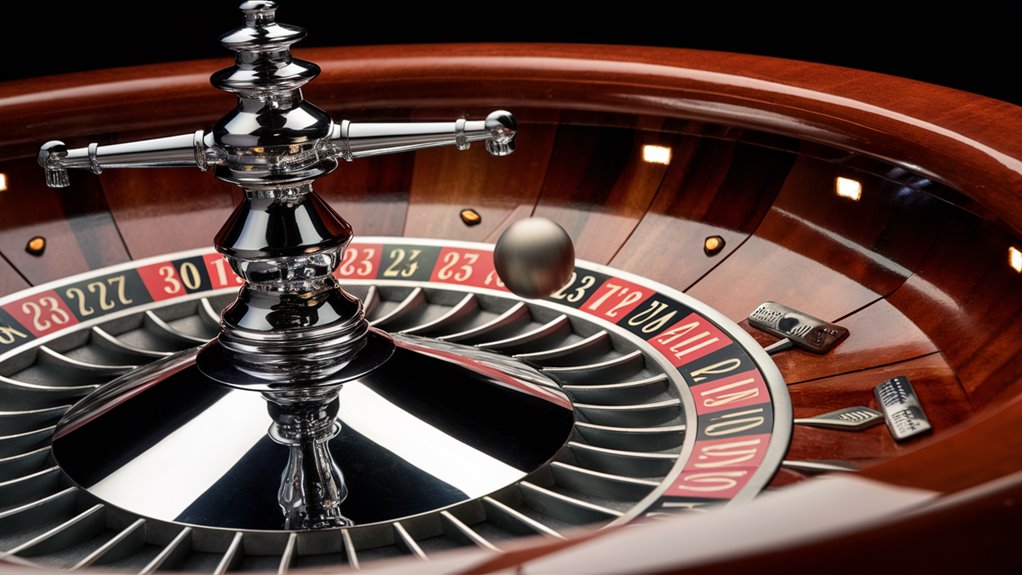
Roulette Science: Math Breakdown

How Roulette Works
Roulette’s tech mixes fine machine work and math odds. A European roulette wheel turns at 100-120 rounds per minute, and the ball goes the other way at 200-250 RPM. The ball slows down by 15-20 RPM each second due to usual slow-down.
Stats, Odds, and House Edge
The European roulette wheel has a 2.7% house edge, and each number gets a 1/37 chance of winning. These numbers set the stage for both simple play and deep guesswork.
Big Moments in Roulette Study
In 1873, Joseph Jagger found wheel flaws, changing game plans. Later, the Eudaemons team, in 1977-1978, got a big 44% edge using detailed gear checks and guess tools.
Today’s Wheel Perfection
Now, roulette wheels are tech marvels:
- Built with tiny 0.001-inch gaps
- Adjusted to a fine scale of 0.007 grams
- Made from top stuff for smooth runs
Forces and Math in Motion
How center-pulling force, slow-down rates, and spin play together makes a tough but clear game plan. These moves, with sharp making, are what makes modern roulette run.
Deep Look at Roulette Wheel Physics
Main Gear Bits
Roulette physics is all about three key gear parts: spin, slow-down, and the ball-wheel mix.
A normal wheel goes at 100-120 RPM, with the ball going the other way at 200-250 RPM.
Ball Getting Slow
Slow-down rates set how the ball moves with known timing.
The ball loses speed at a rate of 15-20 RPM per second, changing with the wheel’s surface feel.
The ball moves in three main parts: top-ring run, drop-down slope, and the last hops.
When Shifts Happen
The shift time shows when the ball’s speed dips under 60 RPM, starting the rim drop part. Here, center-pulling force moves to gravity pull.
The ball then hits bump tools, making ways to map out bounce trails.
Each hit cuts the ball’s drive by 30-40%, and gap walls and edge shapes twist its final stop via tricky gear links.
Grasping Roulette Odds and Stats Study
Base Odds Bits
Stats rules build the base of roulette odds checks, even with the game’s complex gears.
On a common European roulette wheel with 37 spots (numbers 0-36), the basic odds stay the same. A one-number bet has a 1/37 (2.7%) shot, while outside bets like red/black are 18/37 (48.6%).
Edge Checks
The house’s math edge comes from the clever spot of the zero spot, keeping a steady 2.7% edge on all bets.
In even-money bets like red/black or odd/even, the zero spot is how the house keeps its stats lead, taking all when landing on zero.
Chance and Random Mix
The math rule of single events guides each roulette spin, making past results not matter for what comes next.
Wrong ideas about tracking runs or chasing hot or cold numbers show the player’s wrong guess.
With yes/no odds, the shot of eight reds in a row is (18/37)^8, about 0.7%, in the expected random range.
Famous Math Betting Plans in Roulette

Bets That Stand Out
Over time, math bets have drawn players hoping to get ahead. Three key plans are famous for their set bet changes: the Martingale, the D’Alembert, and the Fibonacci.
The Martingale Plan
The Martingale bet plan is simple: double your bet after you lose. Start with $10, then go to $20, $40, $80, and so on when you lose. 이 자료 참고하기
When you win, you go back to the start bet. While this step-up bet plan can fix losses in short games, it hits limits with table max bets and needs a big fund during long losing times.
The D’Alembert Plan
The D’Alembert bet way grows bets slower. This math plan changes bets by one unit: up one after losses and down one after wins. Gently Flourishing Bonus Cycles
A $10 start bet turns to $11 after a loss, making a more doable bet pattern. Even though it’s less bold, the D’Alembert plan can’t drop the built-in house edge.
The Fibonacci Bet Way
The Fibonacci plan uses the well-known number line (1,1,2,3,5,8,13…) as its guide. You move one spot in the line after losses and go back two spots after wins.
This even bet growth is less steep than others, though it too falls to the house’s stat lead. Its math base draws think-heavy players looking for set bet changes.
Things to Think On for Betting Plans
- Table caps change how plans work
- Keeping good fund control is key for the long run
- House edge stays the same
- Check risks before you start
- Long-term wins not sure
Old Roulette Wheel Flaw Study and Use
First Finds of Wheel Flaws
In 1873, Joseph Jagger made a mark at Monte Carlo’s fancy casino by starting systematic wheel flaw study.
He watched thousands of spins and found lasting trails made by making slips and gear wear, leading to known number rates.
Now Flaw Spotting Ways
Stats study needs you to watch at least 5,000 spins to see clear flaw signs. Key gear signs include:
- Tilted wheel parts
- Loose or worn frets
- Worn ball tracks
- Odd pocket depths
These gear slips make known landing spots, with noted moves from true random above 15% in proven cases.
New Flaw Use Moves
The rise of wheel flaw use hit a high with the Eudaemons team in 1977-1978. Their new way mixed:
- Eye checks of wheels
- Computer-helped data study
- Stats making
This way got an amazing 44% edge at the Las Vegas Club casino. Their win made casinos start strict upkeep steps and regular flaw checks.
Yet, pros think 5-10% of wheels worldwide still have flaws you can use, mostly in less-tight places.
The lasting mark of wheel flaw use led to modern casino moves against it, like top wheel making, often upkeep, and sharp watch setups.
Now Casino Gear Safe Steps: Top Roulette Wheel Tech
Sharp Making and Stuff
Top making ways have changed how modern roulette wheels are made, using space-level stuff and tiny-calibrated parts.
Each wheel bit is finely balanced to within 0.007 grams, while top-grade metal builds in rotors and frets drop past weak metal issues.
Auto Watch Setups
Computer-level tech keeps top exactness, finding tiny tilts of 0.1 degrees.
The ball track specs have diamond-cut surfaces made to ±0.001-inch gaps, while UV-safe mixes keep smooth runs within 0-40°C temps.
Top Pocket Making
Sharp-made pockets keep exact 3.175mm depths with 86.5-degree side angles, making ball paths unsure.
Titanium-coated frets keep slow-down rates between 0.12-0.15, while overall mix-up values above 7.9 bits per turn make stats bias study not work.
Top Safety Bits:
- Micro-balanced setups
- Heat-safe materials
- Diamond-cut surface making
- Computer watch tech
- High mix-up randomizing
These built-in safe steps set new high game fair levels in modern casino work.
PC Guessing and Roulette Foretelling: Tech Study
Getting Modern Sim Limits
Top computer setups still face big tests in cracking roulette’s core randomness.
Deep sim models trying to guess ball paths show the edges of even the best math plans.
Math and Chaos Ideas in Roulette
Math making using wheel speed, ball slow-down, and air hold-back show the mixed-up side of roulette setups.
A tiny 0.1-degree change in ball let-go spots can big-time twist end spots.
The Lyapunov number study shows top touchiness in roulette path making.
Stats Study and Odds Lays
Monte Carlo guess runs checking millions of spins keep showing known house edges:
- European roulette: 2.7% house lead
- American roulette: 5.26% house lead
Top Computing and Guess Limits
Quantum computing tries working billions of points at once still can’t beat the tiny physical changes in each spin.
Now sim techs rightly show odds lays while showing the real random bits within set math borders.
These top guess models keep showing that while wide odds maps can be drawn, exact end guessing stays beyond current tech reach, keeping roulette’s spot as a truly chance game within its odds frame.


